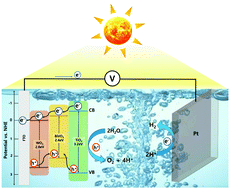Photoelectrochemical H2 evolution on WO3/BiVO4 enabled by single-crystalline TiO2 overlayer modulations†
Abstract
Tungsten oxide/bismuth vanadate (WO3/BiVO4) has emerged as a promising photoanode material for photoelectrochemical (PEC) water splitting owing to its facilitated charge separation state differing significantly from single phase materials. Practical implementation of WO3/BiVO4 is often limited by poor stability arising from the leaching of V5+ from BiVO4 during PEC operations. Herein, we demonstrate that the synthesis of a tungsten oxide/bismuth vanadate/titanium oxide (WO3/BiVO4/TiO2) heterostructure onto a fluorine-doped tin oxide-coated glass substrate through a combined simple hydrothermal-spin coating strategy will advance PEC performance while slowing water oxidation kinetics and improving photostability. We show that surface postmodification with a nanometer-thick layer of (1 0 1) monofacet-selective single-crystalline TiO2 provides stable photocurrent density, up to 1.04 mA cm−2 at 1.23 V (compared to a reversible hydrogen electrode in 0.5 M Na2SO4), with excellent quantum efficiency (45% at 460 nm) and long-term photostability (24 h). Interestingly, crystalline TiO2 activation layers behave differently from previous TiO2 amorphous layers, blocking surface defects while improving corrosion resistance, photostability, and the electron transfer process. These results indicate a ≈2.5 times enhancement in photoelectrocatalytic activity related to referenced WO3/BiVO4 photoanodes, encouraging the use of single-crystalline TiO2 modulations to develop a range of materials for PEC/photocatalytic applications.

- This article is part of the themed collection: Nanoscale 2022 Emerging Investigators


 Please wait while we load your content...
Please wait while we load your content...